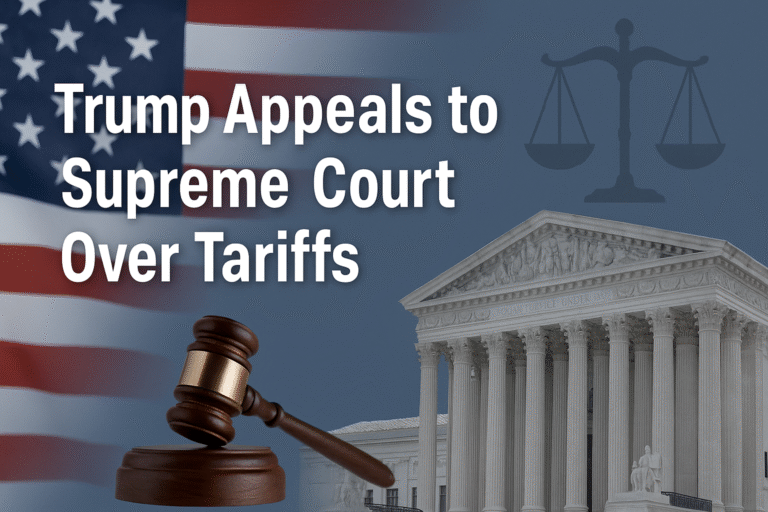Table of Contents
Introduction
The debate over U.S. trade powers has reached its highest legal stage. Former President Donald Trump has formally appealed to the U.S. Supreme Court, asking it to rule on the legality of tariffs imposed under his administration’s emergency powers. This case is not only about trade; it could redefine the constitutional boundaries between the executive branch and Congress.
Background: What Triggered the Case?
In 2024, Trump rolled out sweeping “Liberation Day” tariffs under the International Emergency Economic Powers Act (IEEPA). These measures targeted imports from several nations, including China, Mexico, and Canada, with tariff rates around 10% baseline plus retaliatory hikes.
The administration argued the tariffs were justified on grounds of:
- National security concerns
- Trade imbalances
- Combatting drug trafficking and illicit financing
However, several companies and trade groups challenged the tariffs in the U.S. Court of International Trade (CIT), arguing the president had exceeded his constitutional authority.
Lower Court Rulings Against Trump
- May 2025: The Court of International Trade declared the tariffs unlawful, ruling that the president lacked authority to impose broad, permanent tariff structures without congressional approval.
- August 2025: The Federal Circuit Court of Appeals upheld this decision in a 7–4 ruling, stating that tariff-setting power lies primarily with Congress unless explicitly delegated.
- Enforcement of the ruling was delayed until October 14, 2025, allowing Trump’s legal team to appeal to the Supreme Court.
Trump’s Supreme Court Appeal
On September 3–4, 2025, Trump’s administration filed an emergency petition to the Supreme Court. Key points of the appeal include:
- Urgent Review: A request for expedited consideration, with the Court asked to decide by September 10 whether to hear the case.
- Fast Timeline: Briefings proposed by late October, oral arguments by early November.
- Economic Stakes: Billions in tariffs and active trade negotiations are at risk if the lower court’s decision stands.
- Legal Basis: Trump’s lawyers argue the IEEPA grants the president broad emergency powers, including tariff imposition for national security reasons.
Potential Fallout and Economic Impact
- Refunds to Importers: If the tariffs are overturned, the government could be forced to refund up to $100 billion to U.S. companies.
- Market Instability: The Treasury Department has warned of financial volatility and disruption to trade deals.
- Diplomatic Tensions: Allies like Canada and the EU are closely watching, as a reversal could change the tone of U.S. trade policy.
Legal and Political Implications
- The case raises a constitutional question: Who truly controls U.S. trade policy—the president under emergency powers, or Congress under Article I authority?
- If the Supreme Court sides with Trump, it could expand executive power dramatically.
- If the Court rules against him, it will mark a historic limitation on presidential authority in economic policy.
Conclusion
Trump’s appeal to the U.S. Supreme Court on tariff legality is more than a legal fight—it’s a constitutional showdown. The Court’s decision, expected later this year, could reshape the balance of power in Washington and redefine how America engages with the global economy.
The outcome will not only impact U.S. businesses and trade partners but could set a precedent for future presidents wielding emergency economic powers.

